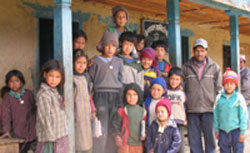 What will the restoration of democracy mean to Nepal's remote regions and marginalised people? Will the Karnali and mountain districts that are untouched by roads finally get a hearing in faraway Kathmandu?
What will the restoration of democracy mean to Nepal's remote regions and marginalised people? Will the Karnali and mountain districts that are untouched by roads finally get a hearing in faraway Kathmandu? The Mahakali Primary School in Langduk in Humla (right) has 100 percent enrollment-all the boys and girls of the village go to school. Living standards in Langduk are higher than even the district capital of Simkot because farmers here sell vegetables that they grow in their own greenhouses. Langduk has a lesson for the rest of Nepal: don't wait for the state to bring development, do it yourself.
All it takes is some seed money or catalytic help to get these regions going. Jumla and Kalikot need the Karnali Highway, Humla urgently needs to finish the Hilsa road to the Chinese border to end its isolation and Mugu could easily be connected once the Martadi road reaches Bajura. "It is the lack of access that is keeping us backward," says Jivan Shahi, the former DDC chairman of Humla. "Once there is a road everything else will follow."
Like elsewhere in the country, the Maoists have come above ground in the far west as well. Along the trails in Humla, guerrillas in civvies walk to Simkot, not even concealing pistols wrapped in black plastic bags. Their mass meetings may be well-attended but it will be difficult to judge real support as long as they keep their weapons.


